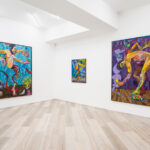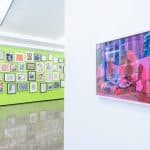Andrew Salgado’s paintings have evolved greatly in style since the large-scale, painterly portraits he began painting about a decade ago, where large swathes of colour played across the surface to define his subjects. In his most recent work – the representational has given way to the more abstract. Now colourful, symbolic, and compositional elements are the driving force of the painted image, but a complex interweaving of figures remain a common thread.
Today his subjects are depicted in a fantastical, often ominous tableaux, with any combination of patterns, abundance, and excess play upon the painted surface, including harlequin-like figures, the motif of a heavy, low-hanging moon; or other unrecognisable figurative shapes sift in and out of the composition, partially obscured or partially revealed. Where there once was a desire to place the figure at the forefront of the image, now there is a kind of harmonious cacophony that creates a sort of chaotically orchestrated puzzle.
There are abundant references to the tradition of figurative painting both historic and contemporary: Matisse, Gauguin, and Bacon are all readily recalled; while contemporary greats like Tal R, Daniel Richter, and Peter Doig are also referenced with equal reverie and respect – often like quiet in-jokes for a viewer to catch.































